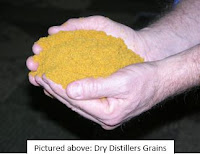 The use of
byproducts in livestock diets has steadily increased over the last ten years especially
and has allowed for increased energy efficiencies, more cost effective food
sources, and sustainable practices. Distillers grains byproducts off the ethanol
industry can be utilized both dried as well as wet throughout the livestock
sectors. The inclusion of these waste products is quite beneficial to the diet
of the animal because it provides energy and protein. The nutrients within
distillers grains are pretty readily available to the animal due to the prior
processing the product has previously undergone which means they’re easily
digestible and thus usable to the animal for growth and production. According
to an ERS report, for every bushel of corn that is processed by an ethanol
plant there's 2.8 gallons of fuel and nearly 17.5 pounds of animal feed. That
is an incredible statistic to think about when you consider what we actually
are attempting to produce is the fuel, and for every 56 pounds (the weight of a
bushel), we only receive 2.8 gallons (approximately 23.35 pounds) of the
product we are striving for and then 17.5 pounds of waste is produced, in which
will ultimately need to be utilized by another industry or disposed of. That is a large amount of
waste product which would possibly go unused without the livestock production
industry’s intervention. When it comes to the sugar-beet industry, the molasses
byproduct is a widely utilized waste. The byproduct sugar-beet molasses
provides a high energy product and aids in dust control and overall
palatability as well. Nearly 4-5% of the weight of every beet is produced as
beet molasses waste, making a large amount of this byproduct when processed in
surplus.
The use of
byproducts in livestock diets has steadily increased over the last ten years especially
and has allowed for increased energy efficiencies, more cost effective food
sources, and sustainable practices. Distillers grains byproducts off the ethanol
industry can be utilized both dried as well as wet throughout the livestock
sectors. The inclusion of these waste products is quite beneficial to the diet
of the animal because it provides energy and protein. The nutrients within
distillers grains are pretty readily available to the animal due to the prior
processing the product has previously undergone which means they’re easily
digestible and thus usable to the animal for growth and production. According
to an ERS report, for every bushel of corn that is processed by an ethanol
plant there's 2.8 gallons of fuel and nearly 17.5 pounds of animal feed. That
is an incredible statistic to think about when you consider what we actually
are attempting to produce is the fuel, and for every 56 pounds (the weight of a
bushel), we only receive 2.8 gallons (approximately 23.35 pounds) of the
product we are striving for and then 17.5 pounds of waste is produced, in which
will ultimately need to be utilized by another industry or disposed of. That is a large amount of
waste product which would possibly go unused without the livestock production
industry’s intervention. When it comes to the sugar-beet industry, the molasses
byproduct is a widely utilized waste. The byproduct sugar-beet molasses
provides a high energy product and aids in dust control and overall
palatability as well. Nearly 4-5% of the weight of every beet is produced as
beet molasses waste, making a large amount of this byproduct when processed in
surplus. One thing the world cannot claim the
livestock feeding industry lacks is the flair to be resourceful. Producers have configured a way
in which to use waste from other industries efficiently within their own production,
which is truly remarkable. The ability to include and understand the benefits
of these products adds to the sustainability of livestock production. There
will always be fuel production and I don’t see the production of sugar tanking
in the near future, so the waste from this industries allows for increased efficiencies
across the various industries and for a relationship in which all involved
benefit.
One thing the world cannot claim the
livestock feeding industry lacks is the flair to be resourceful. Producers have configured a way
in which to use waste from other industries efficiently within their own production,
which is truly remarkable. The ability to include and understand the benefits
of these products adds to the sustainability of livestock production. There
will always be fuel production and I don’t see the production of sugar tanking
in the near future, so the waste from this industries allows for increased efficiencies
across the various industries and for a relationship in which all involved
benefit.
Sources:
No comments:
Post a Comment